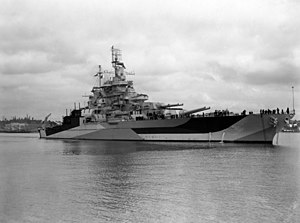
Back Уест Вирджиния (линеен кораб, 1921) Bulgarian USS West Virginia (BB-48) Catalan USS West Virginia (BB-48) Czech USS West Virginia (1921) Danish USS West Virginia (BB-48) German USS West Virginia (BB-48) Spanish یواساس وست ویرجینیا Persian USS West Virginia (BB-48) French USS West Virginia (skip út 1923) Frisian וירג'יניה המערבית (BB-48) HE
 USS West Virginia (BB-48) after her reconstruction, in July 1944
| |
| History | |
|---|---|
| Name | West Virginia |
| Namesake | State of West Virginia |
| Ordered | 5 December 1916 |
| Builder | Newport News Shipbuilding |
| Laid down | 12 April 1920 |
| Launched | 17 November 1921 |
| Commissioned | 1 December 1923 |
| Decommissioned | 9 January 1947 |
| Stricken | 1 March 1959 |
| Fate | Sold for scrap, 24 August 1959 |
| General characteristics (Original configuration) | |
| Class and type | Colorado-class battleship |
| Displacement |
|
| Length | 624 ft (190 m) |
| Beam | 97 ft 6 in (29.72 m) |
| Draft | 30 ft 6 in (9.30 m) |
| Installed power |
|
| Propulsion | |
| Speed | 21 kn (39 km/h; 24 mph) |
| Range | 8,000 nmi (15,000 km; 9,200 mi) at 10 kn (19 km/h; 12 mph) |
| Complement |
|
| Armament | |
| Armor |
|
| General characteristics (Final configuration) | |
| Beam | 114 ft (35 m) |
| Sensors and processing systems | CXAM-1 radar |
| Armament |
|
USS West Virginia (BB-48) was the fourth dreadnought battleship of the Colorado class, though because Washington was cancelled, she was the third and final member of the class to be completed. The Colorado class proved to be the culmination of the standard-type battleship series built for the United States Navy in the 1910s and 1920s; the ships were essentially repeats of the earlier Tennessee design, but with a significantly more powerful main battery of eight 16-inch (406 mm) guns in twin-gun turrets. West Virginia was built between her keel laying in 1920 and her commissioning into the Navy in 1923. The ship spent the 1920s and 1930s conducting routine training exercises, including the typically-annual Fleet Problems, which provided invaluable experience for the coming war in the Pacific.
West Virginia was moored on Battleship Row on the morning of 7 December 1941 when Japan attacked Pearl Harbor, bringing the United States into World War II. Badly damaged by torpedoes, the ship sank in the shallow water but was later refloated and extensively rebuilt over the course of 1943 and into mid-1944. She returned to service in time for the Philippines Campaign, where she led the American line of battle at the Battle of Surigao Strait on the night of 24–25 October. There, she was one of the few American battleships to use her radar to acquire a target in the darkness, allowing her to engage a Japanese squadron in what was the final action between battleships in naval history.
After Surigao Strait, the ship remained in the Philippines to support troops fighting during the Battle of Leyte in 1944 and then supported the invasion of Lingayen Gulf in early 1945. The ship also took part in the Battles of Iwo Jima and Okinawa later that year, providing extensive fire support to the ground forces invading those islands. During the latter operation, she was hit by a kamikaze that did little damage. Following the surrender of Japan, West Virginia took part in the initial occupation and thereafter participated in Operation Magic Carpet, carrying soldiers and sailors from Hawaii to the mainland United States before being deactivated in 1946. She was decommissioned in 1947 and assigned to the Pacific Reserve Fleet, where she remained until 1959 when she was sold to ship breakers and dismantled.
© MMXXIII Rich X Search. We shall prevail. All rights reserved. Rich X Search